Related Research Articles

Pope Evaristus was the bishop of Rome from c. 99/100 to his death in 107/108. He was also known as Aristus and is venerated as a saint in the Eastern Orthodox Church, the Catholic Church, and Oriental Orthodoxy. It is likely that John the Apostle died during his reign period, marking the end of the Apostolic Age.

Pope Zephyrinus was the bishop of Rome from the year 199 until his death on 20 December 217. He was born in Rome, and succeeded Victor I. Upon his death on 20 December 217, he was succeeded by his principal advisor, Callixtus I. He is known for combating heresies and defending the divinity of Christ.

Hippolytus of Rome was a Bishop of Rome and one of the most important second–third centuries Christian theologians, whose provenance, identity and corpus remain elusive to scholars and historians. Suggested communities include Rome, Palestine, Egypt, Anatolia and other regions of the Middle East. The best historians of literature in the ancient church, including Eusebius and Jerome, openly confess they cannot name where Hippolytus the biblical commentator and theologian served in leadership. They had read his works but did not possess evidence of his community. Photios I of Constantinople describes him in his Bibliotheca as a disciple of Irenaeus, who was said to be a disciple of Polycarp, and from the context of this passage it is supposed that he suggested that Hippolytus so styled himself. This assertion is doubtful. One older theory asserts he came into conflict with the popes of his time and seems to have headed a schismatic group as a rival to the bishop of Rome, thus becoming an antipope. In this view, he opposed the Roman Popes who softened the penitential system to accommodate the large number of new pagan converts. However, he was reconciled to the Church before he died as a martyr.
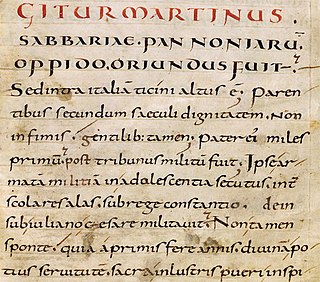
A hagiography is a biography of a saint or an ecclesiastical leader, as well as, by extension, an adulatory and idealized biography of a preacher, priest, founder, saint, monk, nun or icon in any of the world's religions. Early Christian hagiographies might consist of a biography or vita, a description of the saint's deeds or miracles, an account of the saint's martyrdom, or be a combination of these.

Saint Valentine was a 3rd-century Roman saint, commemorated in Western Christianity on February 14 and in Eastern Orthodoxy on July 6. From the High Middle Ages, his feast day has been associated with a tradition of courtly love. He is also a patron saint of Terni, epilepsy and beekeepers. Saint Valentine was a clergyman – either a priest or a bishop – in the Roman Empire who ministered to persecuted Christians. He was martyred and his body buried on the Via Flaminia on February 14, which has been observed as the Feast of Saint Valentine since at least the eighth century.

The Syriac Orthodox Church, also known as West Syriac Church or West Syrian Church, officially known as the Syriac Orthodox Patriarchate of Antioch and All the East, and informally as the Jacobite Church, is an Oriental Orthodox church that branched from the Church of Antioch. The bishop of Antioch, known as the patriarch, heads the church and possesses apostolic succession through Saint Peter, according to sacred tradition. The church upholds Miaphysite doctrine in Christology, and employs the Liturgy of Saint James, associated with James the Just. Classical Syriac is the official and liturgical language of the church.

The Greek Orthodox Patriarchate of Antioch, also known as the Antiochian Orthodox Church and legally as the RūmOrthodox Patriarchate of Antioch and All the East, is an autocephalous Greek Orthodox church within the wider communion of Eastern Orthodox Christianity that originates from the historical Church of Antioch. Headed by the Greek Orthodox patriarch of Antioch, it considers itself the successor to the Christian community founded in Antioch by the Apostles Peter and Paul. It is one of the largest Christian denominations of the Middle East, alongside the Copts of Egypt and the Maronites of Lebanon.
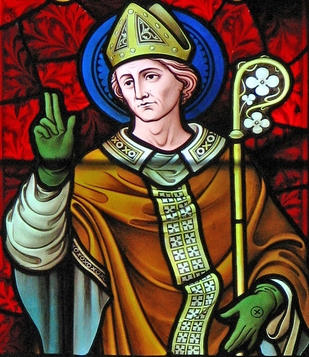
Birinus was the first Bishop of Dorchester and was known as the "Apostle to the West Saxons" for his conversion of the Kingdom of Wessex to Christianity. He is venerated as a saint by the Roman Catholic Church, the Eastern Orthodox Church, and Anglican churches.

Richarius of Celles was a Frankish hermit, monk, and the founder of two monasteries. He is venerated as a saint in the Catholic and Eastern Orthodox Churches.
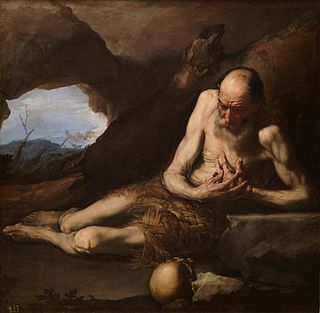
Paul of Thebes, commonly known as Paul the First Hermit or Paul the Anchorite, was an Egyptian saint regarded as the first Christian hermit and grazer, who was claimed to have lived alone in the desert of Thebes, Roman Egypt from the age of 16 to the age of 113 years old. He was canonized in 491 by Pope Gelasius I, and is venerated as a saint by the Catholic Church, Eastern Orthodox Church, and Oriental Orthodox Churches.

Saint Alban is venerated as the first-recorded British Christian martyr, for which reason he is considered to be the British protomartyr. Along with fellow Saints Julius and Aaron, Alban is one of three named martyrs recorded at an early date from Roman Britain. He is traditionally believed to have been beheaded in Verulamium sometime during the 3rd or 4th century, and has been celebrated there since ancient times.
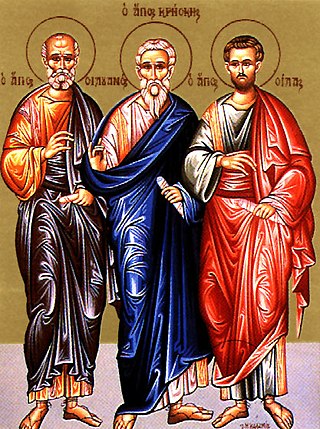
Crescens was an individual who appears in the New Testament. He is traditionally considered one of the 72 disciples sent out by Jesus in Luke 10. He was a missionary in Galatia and became a companion of Paul. The name 'Crescens' is the present-active participle of the Latin word crescere, and means 'increasing'.

The Four Crowned Martyrs or Four Holy Crowned Ones were nine individuals who are venerated as martyrs and saints of Early Christianity. The nine saints are divided into two groups:
- Severus, Severian(us), Carpophorus (Carpoforus), Victorinus
- Claudius, Castorius, Symphorian (Simpronian), Nicostratus, and Simplicius

Alexander of Jerusalem was a third century bishop who is venerated as a martyr and saint by the Eastern Orthodox Church, Oriental Orthodox churches, and the Roman Catholic Church. He died during the persecution of Emperor Decius.
Julius and Aaron were two Romano-British Christian saints who were martyred around the third century AD. Along with Saint Alban, they are the only named Christian martyrs from Roman Britain. Most historians place the martyrdom in Caerleon, although other suggestions have placed it in Chester or Leicester. Their feast day was traditionally celebrated on 1 July, but it is now observed together with Alban on 20 June by the Roman Catholic and Anglican Churches.

Saints Cyprian and Justina are honored in the Catholic Church, Eastern Orthodox Church and Oriental Orthodoxy as Christians of Antioch, who in 304, during the Diocletianic Persecution, suffered martyrdom at Nicomedia on September 26. According to Roman Catholic sources, no Bishop of Antioch bore the name of Cyprian.
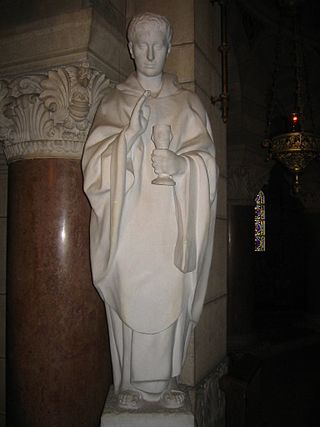
Saints Ferreolus and Ferrutio are venerated as martyrs and saints by the Catholic Church, especially in Besançon where they are honored as its patron saints.
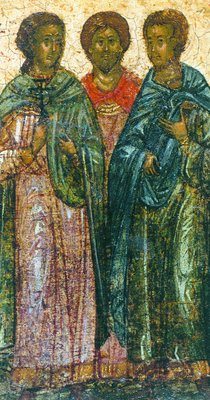
Basiliscus of Comana, also known as Basiliscus of Pontus, was a Greek martyr. His feast day is 22 May, or 30 July in the Greek calendar.
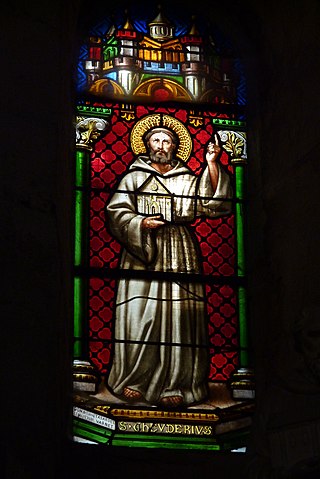
Saint Theuderius was a Christian monk, abbot and hermit. His feast day is 29 October.
References
- ↑ Husenbeth, F. C. (Frederick Charles); Jessopp, Augustus; Blackburne, Edward Lushington; Marsh, William (1882). Emblems of saints. Norwich, Printed by A. H. Goose and co. Retrieved 13 October 2021.
- ↑ "Saint Severus of Vienne". CatholicSaints.Info. 7 August 2010. Retrieved 2 September 2021.
- ↑ Abbey, Saint Augustine's; Press, Aeterna (1966). The Book of Saints. Aeterna Press. Retrieved 2 September 2021.
- ↑ Kurikilamkatt, James (31 December 2005). First Voyage of the Apostle Thomas to India: Ancient Christianity in Bharuch and Taxila. ISD LLC. ISBN 978-1-925612-63-9 . Retrieved 2 September 2021.
- ↑ Raisharma, Sukanya (January 2021). "Much Ado about Vienne? A Localizing Universal Chronicon". Historiography and Identity III: Carolingian Approaches. Cultural Encounters in Late Antiquity and the Middle Ages. 29. Brepols Publishers: 271–290. doi:10.1484/m.celama-eb.5.120167. ISBN 978-2-503-58655-7. S2CID 234198159 . Retrieved 2 September 2021.
- ↑ The Roman Martyrology. Baltimore : John Murphy. 1916. p. 237. Retrieved 2 September 2021.
- ↑ "Saint Séver". nominis.cef.fr. Retrieved 22 September 2021.
- ↑ "Thursday, 21st January, 1915". Proceedings of the Society of Antiquaries of London. 27: 54–67. June 1915. doi:10.1017/S0950797300013512 . Retrieved 2 November 2021.
- ↑ Thomas, P. (17 December 2020). Christians and Christianity in India and Pakistan: A General Survey of the Progress of Christianity in India from Apostolic Times to the Present Day. Routledge. ISBN 978-1-000-22821-2 . Retrieved 2 September 2021.